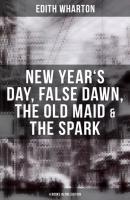Edith Wharton: New Year's Day, False Dawn, The Old Maid & The Spark (4 Books in One Edition). Edith Wharton
Чтение книги онлайн.

Читать онлайн книгу Edith Wharton: New Year's Day, False Dawn, The Old Maid & The Spark (4 Books in One Edition) - Edith Wharton страница
Название: Edith Wharton: New Year's Day, False Dawn, The Old Maid & The Spark (4 Books in One Edition)
Автор: Edith Wharton
Издательство: Bookwire
Жанр: Языкознание
isbn: 9788027236305
isbn:
Edith Wharton
Edith Wharton: New Year's Day, False Dawn, The Old Maid & The Spark
(4 Books in One Edition)
Published by
Books
- Advanced Digital Solutions & High-Quality eBook Formatting -
2017 OK Publishing
ISBN 978-80-272-3630-5
Table of Contents
False Dawn
Part 1.
Chapter 1.
Chapter 2.
Chapter 3.
Chapter 4.
Chapter 5.
Chapter 6.
Chapter 7.
Chapter 8.
Chapter 9.
The Old Maid
Chapter 1.
Chapter 2.
Chapter 3.
Chapter 4.
Chapter 5.
Chapter 6.
Chapter 7.
Chapter 8.
Chapter 9.
Chapter 10.
Chapter 11.
The Spark
Chapter 1
Chapter 2
Chapter 3
Chapter 4
Chapter 5
New Year’s Day
Chapter 1
Chapter 2
Chapter 3
Chapter 4
Chapter 5
Chapter 6
Chapter 7
False Dawn
Part 1.
1.
HAY, verbena and mignonette scented the languid July day. Large strawberries, crimsoning through sprigs of mint, floated in a bowl of pale yellow cup on the verandah table: an old Georgian bowl, with complex reflections on polygonal flanks, engraved with the Raycie arms between lions’ heads. Now and again the gentlemen, warned by a menacing hum, slapped their cheeks, their brows or their bald crowns; but they did so as furtively as possible, for Mr. Halston Raycie, on whose verandah they sat, would not admit that there were mosquitoes at High Point.
The strawberries came from Mr. Raycie’s kitchen garden; the Georgian bowl came from his great-grandfather (father of the Signer); the verandah was that of his country-house, which stood on a height above the Sound, at a convenient driving distance from his town house in Canal Street.
“Another glass, Commodore,” said Mr. Raycie, shaking out a cambric handkerchief the size of a table-cloth, and applying a corner of it to his steaming brow.
Mr. Jameson Ledgely smiled and took another glass. He was known as “the Commodore” among his intimates because of having been in the Navy in his youth, and having taken part, as a midshipman under Admiral Porter, in the war of 1812. This jolly sunburnt bachelor, whose face resembled that of one of the bronze idols he might have brought back with him, had kept his naval air, though long retired from the service; and his white duck trousers, his gold-braided cap and shining teeth, still made him look as if he might be in command of a frigate. Instead of that, he had just sailed over a party of friends from his own place on the Long Island shore; and his trim white sloop was now lying in the bay below the point.
The Halston Raycie house overlooked a lawn sloping to the Sound. The lawn was Mr. Raycie’s pride: it was mown with a scythe once a fortnight, and rolled in the spring by an old white horse specially shod for the purpose. Below the verandah the turf was broken by three round beds of rose-geranium, heliotrope and Bengal roses, which Mrs. Raycie tended in gauntlet gloves, under a small hinged sunshade that folded back on its carved ivory handle. The house, remodelled and enlarged by Mr. Raycie on his marriage, had played a part in the Revolutionary war as the settler’s cottage were Benedict Arnold had had his headquarters. A contemporary print of it hung in Mr. Raycie’s study; but no one could have detected the humble outline of the old house in the majestic stone-coloured dwelling built of tongued-and-grooved boards, with an angle tower, tall narrow windows, and a verandah on chamfered posts, that figured so confidently as a “Tuscan Villa” in Downing’s “Landscape Gardening in America.” There was the same difference between the rude lithograph of the earlier house and the fine steel engraving of its successor (with a “specimen” weeping beech on the lawn) as between the buildings themselves. Mr. Raycie had reason to think well of his architect.
He thought well of most things related to himself by ties of blood or interest. No one had ever been quite sure that he made Mrs. Raycie happy, but he was known to have the highest opinion of her. So it was with his daughters, Sarah Anne and Mary Adeline, fresher replicas of the lymphatic Mrs. Raycie; no one would have sworn that they were quite at ease with their genial parent, yet every one knew СКАЧАТЬ